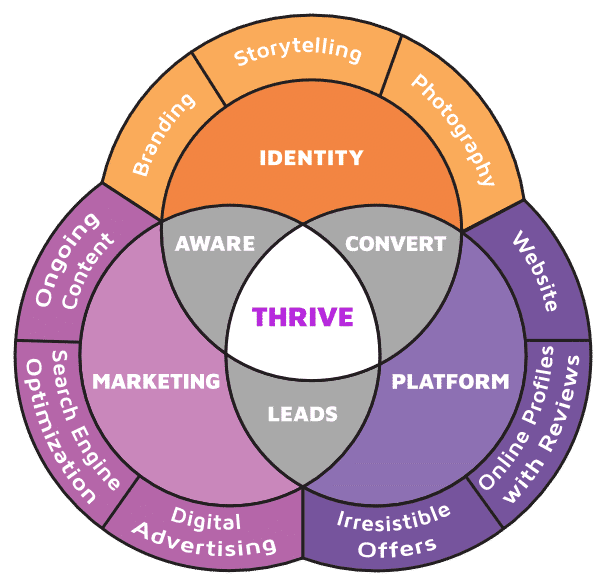Your visitors come to your website got there because of a specific search for your product or service. They need what you're selling but when they get there, they also need the answers to some basic questions. So what do you put on your website? If they can't answer those questions on the first page of your website, they will be heading to your competitor's site before you know it.
Getting visitors to your website is the all-important first step. Once they are there, your goal is to keep them there and, maybe, direct them into a sales or information funnel. To keep them around, you need to give them the information they are looking for once they land on your homepage.

It can be easy to assume that because this visitor searched for and clicked on your website, they know what they're looking for and how it can help them. However, just because someone knows they are looking for a realtor or HVAC repair service doesn't mean they know how YOUR realty firm or HVAC company can help them.
Are you known for excellent customer service? Speed? Quality products? If you're in a non-essential business, maybe landscaping or pool installation, you need to make the case for why this person who may be thinking about relandscaping or adding in a pool should make that investment.

The next thing visitors are looking to know is how you are different from your competitors. Why should they choose to work with you? Why should they choose your product over the same, or similar, product made by your competitors?
Again, this could come down to the speed or quality of your service. The history of your company and your mission and values, the ingredients you use in your product, the story of how your company started can all set you apart from your competitors and will humanize your company in a way that will have visitors identifying with your story, which is a great way to build brand loyalty.
Featured Reading: Top 10 Things Every Website Needs

Visitors want to be able to easily find the information they need. If your website lacks a clear navigational structure, your visitors will get frustrated and leave before buying your product or service.
Studies have shown that 50% of visitors will use your site's navigation menu to orient themselves once they get to your site from a referral site. If your site has an overly complicated navigation structure, you're not doing yourself any favors in getting people to stick around.

One of the biggest factors in the decision to make a purchase is whether the visitor trusts you or not. If there's even a doubt about the legitimacy of your business and your website, visitors will leave. Luckily, there are a few things you can do to demonstrate the trustworthiness of your business:
Featured Reading: How to Build Trust & Grow Your Business

This last one isn't so much a question as an expectation. Visitors want details about your product in an easy-to-digest manner. That means bullet points, not text blocks. Images and video demonstrations. Short paragraphs of no more than 3-4 sentences.
As web users, we're used to scanning pages to get the information we want. We save our dedicated attention spans for e-books and news articles. When we're looking at products and services, we want access to all the relevant information, and we want easy and fast.
A well-designed homepage with an easy-to-understand navigational structure, intuitive sales funnels, and clear, compelling content is what your business needs to knock out your competition. If you think your homepage is falling short, give us a call. We'd love to help you out.
When visitors land on your website or your social media channels, your words need to capture their attention and not let it go. Copywriting and storytelling are the keys to engaging your audience in meaningful ways that can convert visitors into lifelong customers.
Your story is unique to your business. It’s a big thing that separates you from your competitors, and it’s a great way to relate to your customers. Copywriting and storytelling are how you can compellingly tell your story and weave that story into every aspect of your marketing. To have the impact you want, your content needs to sing.

You see copywriting everywhere. It’s on all the advertising you see. It’s in all of the emails your receive from your favorite experts, companies, and brands. It’s in your favorite how-to guides, blog posts, and podcasts.
Whether you realize it or not, your business already engages in copywriting. All of the text on your website? Copywriting. Your social media channels? Copywriting. The scripts you give your salespeople? Copywriting. Emails you send, fliers you make, advertising you buy? Copywriting.
Sometimes, quality copywriting is what differentiates you from your competition. Poor copywriting can leave potential customers confused about how your product or service can help them with the problem they are trying to solve. It can leave potential customers feeling disengaged or not connected with your business. It can even make them think they are not your target audience.
Good copywriting, on the other hand, will make your brand stand out among the competition. Good copywriting welcomes your target audience through the language and tone used, as well the specific words chosen. Consistently used, good copywriting can give your brand a unique voice in your industry.
By having a recognizable brand voice, you give your customers something to identify with and remember you by. Customers that know your brand, understand your product, and remember your voice are much more likely to become repeat customers and recommend you to others.

Content marketing has become the go-to strategy for businesses looking to dominate online. Well-written copy that is appropriately targeted to your audience will show them the power of your product or service in solving their problems. It can convince them of the superiority of your product or service to that of your competitors.
Investment in a content marketing strategy based on good copywriting can have many benefits for your business.
72% of online marketers say that content creation is their number one SEO tactic. Google agrees. It penalizes websites with poor content by ranking them lower than sites with higher quality content. Google knows this through monitoring the bounce rate, page depth, and time spent on the site
Professional copywriters know how to target the keywords you’ve identified as bringing in the most traffic. They can weave those into your copy naturally, a strategy loved by both users and search engines alike. They know how to write powerful calls to action and how to place links that encourage users to click through.
Bottom line, they know how to create webpages and blog posts that rank well.
Have you ever spent time on a page that was hard to read? Whether it’s confusing, uses language that doesn’t resonate with you, or is just poorly written, if you’ve come across a webpage like this, you probably didn’t spend much time on it.
A well-written website, landing page, or email is a much more enjoyable experience for your audience. They may even find some pleasure in reading through your content when it’s well written. It will keep them more engaged and more motivated to do business with you.
The bottom line is that good copy can increase your bottom line. Powerful calls-to-action and copy explaining the benefits and advantages of your product or service can motivate potential customers to take that next step to become paying customers. Unless properly motivated, it’s easy for visitors to leave your website thinking they should make a purchase but not taking that all-important final step: making a purchase.
Are you in a crowded industry or one where your product or service is complicated? Are you selling something new or unique that people are unfamiliar with? If so, you need copy that powerfully sells your customer on the benefit of using YOUR product or service and why your potential customers need it.
Good copy can persuade potential customers that are on the fence about the benefits of working with you and purchasing your product or service.
We are inundated with words every day. From our scrolling through social media to overwhelmed inboxes, to advertisements in between it all, we see more than our fair share of things to read throughout the day. When you want to stand out from the crowd and actually be remembered, it’s time to invest in good copywriting.
Good copy evokes emotion. It is not just about constructing sentences in English and posting them. It taps into your audiences’ feelings and emotions and leaves them with the knowledge that you, your product, or your service can help make their lives better and easier. By going beyond the intellectual and tapping into the emotional, your message automatically becomes more memorable.

People visiting your website are looking for you to be the expert they need. They’re looking for help solving a problem from someone who is knowledgeable and has experience with their particular problem.
They are not looking for someone who may know everything about, say, painting but can’t be bothered to proofread their website. There’s something about typos, misspellings, and hard to read sentences that turn people off. It takes away from your authority, even if you are the best painter in town.
Good copywriters can help ensure that your website is error-free, easy to read, and engaging.
Even if you have impeccable grammar and a firm understanding of how to write to engage people, that’s not why you got into the painting business, to continue with this analogy. You got in it because you love to paint houses.
However, the internet is not going anywhere and the fact remains that you need to produce new content regularly to maintain and improve your search engine standings. Businesses that blogged daily earn 82% more customers than those that don’t.
Blogging daily isn’t sustainable or feasible for most businesses as the quality of content is as important as the frequency. But this stat goes to show that creating new content is important for earning new customers.
Good copywriters can help populate your website with fresh content regularly. The best copywriters can do it in a way that your customers never know it’s not you writing the content.
Whether you hire a copywriter or tackle the job yourself, it’s important to understand how vital good content is to your business. As you move on to the next steps of our Blueprint for Online Excellence, it’s all balancing on the foundation built by your website’s content.
You want as sturdy a foundation as possible. You want a foundation that shows your target audience you are a business they can trust. Any digital marketing strategy you implement needs to be based on effective content. Effective content is dependant on effective copywriting.
Effective copywriting? Well, for that it's not a bad idea to invest in a professional copywriter.

—
Thrive Design is a customer-centric web design and marketing company from Seattle. Contact us today to find out how we can elevate your business online! Find us on Clutch, UpCity, LinkedIn, Facebook, and Twitter.
When I'm working with clients, I use the same framework for establishing online dominance that I have used for my own business. These nine elements haven't steered me wrong in the many years that I have been building websites for businesses.
The first element that I tackle with all my clients is brand identity. A strong brand identity makes you more memorable, makes your marketing more cohesive, and gives your customers something to relate with.

Let’s start with the basics. A strong brand identity is more than a logo. Brand identity encompasses the look and feel of your website. It's how you talk about your business. It's what first comes to your target audience's mind when they hear the name of your business.
Here's an exercise to help you understand more about what is involved with a brand. First, close your eyes and think about Wal-Mart and note the things that you think about. Do you think about the low costs, the colors blue and yellow, a bouncing smiley face or sun icon (depending on how old you are)?
Next, close your eyes and think about Target. Do you think about different things? Maybe quality products, the color red, a small dog, or their collaborations with famous designers or brands?
At the basic level, Wal-Mart and Target are the same store. They are both one-stop-shops for all of your needs. Many have groceries in addition to clothing, home goods, electronics, toys, and sports equipment. They both have seasonal sections where you can get Halloween costumes, pool toys, or Christmas decorations depending on the time of year.
But when you think of each of these stores, you probably thought of very different things. That's because they each have a very specific and very strong brand identity. While a logo or tagline may have also crossed your mind, most of what you thought about probably had nothing to do with either of those. That's because brand identity encompasses more than just a logo or tagline.

Featured Reading: Data-Driven Results: Step 5 of 9 for Dominating Online
Brand identity is a powerful tool you can use to differentiate yourself from your competitors. It's another way you can show yourself to be different from all of the other painters, real estate agents, pool companies, dentists, or whatever business you find yourself in.
A brand gives your company an identity beyond your product or services. Your customers want to do business with a company that isn't just a “dentist” or a “real estate agent.” They want a “family dentist” or a “holistic dentist.” They want a “friendly real estate agent” or a “knowledgeable real estate agent.” Branding gives your customers something to connect with, which makes them feel like they know your business better.
A strong, consistent brand helps you with your marketing and advertising activities. When you have a consistent brand that your audience recognizes and connects with, it gives everything else your company does an extra impact.
A brand makes your company more memorable. When you give your company an identity that your customers connect with, they are more likely to remember you over your competition. They are also more likely to do business with a brand they recognize and identify with.
A strong brand will help you build your business above and beyond where you are now. It will give everything you do more impact and help your customers distinguish you from your competitors in an often crowded marketplace.

The great thing about branding is that you can control these impressions that your business gives to your customers. Everything from the colors you choose, the logo you design, the words you use, and the look and feel of your website can help mold your customers' impressions of your business.
Here are the five things you need to think about when designing your brand:
One of the biggest misconceptions about branding is that your brand is about you and your business. Your brand is FOR your business but it should be ABOUT your audience. They are the ones who interact with your brand on a daily basis. They are the ones you are trying to attract with your brand.
Every decision you make about your brand should be true to your business, yes. But it also needs to be designed to appeal to your audience. If your audience is families with young children, your brand should be bright and cheery even if you prefer muted colors and simple images.
Your mission statement is all about the purpose of your business. It's the statement of why you started your business. You cannot create a brand that people will trust, value, and identify with if you cannot tell them why your business exists or why you're passionate about your business.
Another aspect of your business that needs to be conveyed through your brand is how you are different from your competitors. How does your business improve the lives of your customers? What sets you apart from the other businesses in your field?
Once you have an idea of why your business exists and how it's different from your competitors, the fun starts. Now is the time to figure out how all of this should be conveyed visually through your logo, colors, brand images, colors, and fonts.
If you are uncomfortable with this step, graphic designers can help you zero in on the right look for your brand. They are experts who know how to convey feelings and concepts with images and colors.
The final step is figuring out what you want your brand to sound like. This is called your brand voice.
Do you want a brand voice that is more casual and conversational? Do you want a brand voice that's authoritative and professional? Your target audience, UVP, and mission statement will all point towards the voice that will resonate most with your potential customers.
Once you have determined what you want your brand voice to be, it's very important that it remains consistent. Your customers will become accustomed to your brand voice and, if you deviate from it, it won't resonate as much or as well.
Featured Reading: The Killer Offer: Step 6 of 9 for Dominating Online
Establishing a strong, recognizable brand is the first step to dominating online. Your brand is something that can give you an edge by giving your potential customers a way to understand your business on what feels like a personal level. It gives them something to identify with and a way to differentiate you from your competitors.
For more ways to dominate online, check out our Blueprint for Online Excellence for more strategies to help you increase your online presence and effectiveness.

—
Thrive Design is a customer-centric web design and marketing company from Seattle. Contact us today to find out how we can elevate your business online! Find us on Clutch, UpCity, LinkedIn, Facebook, and Twitter.
The number one way to build trust online is through a robust suite of reviews. Not certifications. Not a slick website. Not even a service guarantee. (Although all those things do help.)
Reviews.
Reviews are the first thing that online consumers turn to when making purchasing decisions. They’re the first thing people see when they Google your business. They’re one of the first things people look for when they come to your website with the intent to purchase.
If you don’t have any reviews, you are missing out on a golden opportunity to grow your business.

I can hear the internal groan and the question that probably immediately popped in your head:
“But how do I get reviews?”
Here’s the revolutionary secret to getting your customers to leave a review: Ask them.
That’s it! It’s that simple.
One reason that consumers are unlikely to leave reviews, especially if they’re satisfied with the service or product, is they don’t think about it. Their experience was so smooth that it blended seamlessly into their daily life and they didn’t need to think about it anymore.
(This is why there’s a stereotype that the only people who leave reviews are dissatisfied. If someone is dissatisfied with a product or service, they tend to fixate on it until they feel they have done something to rectify the situation, usually leaving a review to let other potential customers know about their experience.)
Whether you have 1000 new customers each week or you work with just 1 customer each month, you need to have a streamlined process in place where you are asking your customers for a review after you have delivered your product or service.
Featured Reading: Local SEO is Crucial for Service-Based Companies
Featured Reading: SEO Seattle

The more specific you can be and the easier you can make your ask, the more likely it is that your customers will help you out. So, before you start mass emailing your previous clients, think about exactly what kind of review you want them to leave.
If you want them to leave you a review on Google, Amazon, Trustpilot, Yelp, Angie’s List, or any other specific platform, be sure to include that in your ask along with a link to the exact page you want them to use for their review. The easier you make it for them, the more likely it is they will do what you want them to.
Also, let’s pause real quick and review the term “mass emailing.” Yes, you will be emailing your previous clients but there are good ways AND bad ways to do that.
If you only have a few clients, it’s best to email them individually to ask them to leave a review. The message can be the same but you’re most likely to get a yes from people who feel you reached out personally. A BCC email is not personal.
If you have lots of clients, automation is the way you want to go. The process of automation is actually quite simple.
What you would need to do here is to create an email sequence that consists of one or more emails that are asking your customer to leave a review. You add the customer into your automation sequence and send out an email (or series of emails) asking them to leave you a review. If you already use an email provider such as ActiveCampaign, ConvertKit, Drip, MailerLite, or MailChimp, you should have automation functionality available to you already.

Now that you’ve asked your previous clients for reviews and they’re rolling in, you may think your job is done. But it’s not done quite yet. There are still a few things you need to do.
Say thank you/respond to reviews. One action that truly goes a long way is saying thank you to your customers for their reviews. It can be as easy as responding to the positive review with a simple “thank you!” This also looks good to potential customers who are reading the reviews.
It’s also important to respond to the less stellar reviews. Not only does it address that client’s specific problems or issues, but it also shows that you are a business that cares about everyone’s experience, not just the good ones.
Plan for repurposing the reviews. The answer here is yes. You’ll want to be able to take these reviews and use them on your website, as social media posts, or in other promotional material. Best practice for repurposing reviews is to ask the poster whether or not you can use their review in other ways.
Never incentivize your reviews. Ok so this isn’t something you need to do after asking for reviews, but it is something you need to avoid doing throughout this whole process. While it is acceptable to hold a drawing or raffle for customers who leave reviews, you get into ethically murky waters if you offer something in exchange for a review.
Featured Reading: Looking for More Business? Check Out Your Online Reputation.
Great reviews can massively enhance the reputation of your business and help potential new customers trust that you’re able to assist them with their needs. Whether you sell products or services, it’s important that you’re encouraging your customers to leave reviews. These will show the quality of what you have to offer and in many cases, make a difference in how your business
is viewed in the search engines.
Check out the other steps to creating a website that dominates online with our Blueprint for Online Excellence.

—
Thrive Design is a customer-centric web design and marketing agency from Seattle. Contact us today to find out how we can elevate your business online! Find us on Clutch, UpCity, LinkedIn, Facebook, and Twitter.
The internet was not made for static websites. If you’re not adjusting your website (and tracking what works), you are just asking for your website to wither and die.

Your website is able to give you all kinds of information if you know where to look. This information can be used to tweak your website to better meet the needs of your website’s visitors.
If you’re wondering where to start collecting website data, the place that most people go is Google Analytics. Google has designed its analytics platform to be one of the most robust analytics platforms available.
From your Google Analytics dashboard, you are able to see at a glance which of your pages have the most visitors, which pages have high bounce rates, which pages earn you the most money, and so much more. You are also able to track where your site visitors are coming from, which is especially helpful when you’re running any sort of marketing campaign.
Google Analytics is also designed to work especially well with Google Ads. (Remember step one?) The Google Analytics platform can give you even deeper insights into how users from your Google Ad campaign have interacted with your site.
As deep of a dive as Google Analytics can give you, sometimes you want something more visual, something that can give you an at-a-glance analysis of what people are clicking on when they visit your website.
We love HotJar for just that reason. We use HotJar to analyze our site on a regular basis. They give you access to three very useful tools for analyzing visitor behavior.

HotJar and Google Analytics are great ways to figure what’s working and what’s not on your website, but it’s pretty hard to test how well website changes are working if you can only see data after the fact.
When you want to test tweaks to copy, navigation, or other parts of your website, what you really want to do is conduct some A/B testing.
It sounds complicated, but it’s really not. What A/B testing does is allows you to present two different website versions: one to 50% of your visitors and one to the other 50%. SplitHero is our tool of choice for running A/B tests.
A/B testing doesn’t have to be complicated. It can be for something as simple as swapping out an image or trying a different header for the page. It could be moving up your signup form or lead generation offer to higher on your homepage.
A/B testing is the perfect way to try out some of the ideas you got from all the amazing insights you learned by tracking your website’s performance and visitor behavior.
If you did it well, you used data about your market and target audience to build your website before you launched it. There is no good reason to stop using data to make the ongoing changes needed to keep your website fresh and relevant so you stay top of mind for your clients and potential customers. These tools, and our help, can take your website game to the next level.
Keep Reading: The Killer Offer: Step 6 of 9 for Dominating Online
—
Thrive Design is a customer-centric web design and development company from Seattle. Contact us today to find out how we can elevate your business online! Find us on Clutch, UpCity, LinkedIn, Facebook, and Twitter.
Category: Web design seattle
Your website design is only as good as the leads it brings in. If it isn’t offering valuable content in exchange for a potential lead’s email, you’re leaving money on the table.
That’s the subject of my sixth step for online domination: finding your killer offer.
See Related: How Do You Announce a New Website Launch?

Your killer offer is a valuable piece of content you create that will entice potential leads to enter their email addresses in return for being able to access that content.
For example, I design and build amazing websites that get results for businesses. So my killer offer is a downloadable PDF that outlines the five things you need to know before embarking on a new website project or hiring a website designer.
(In fact, if you’re curious about what five things you need to know before starting a website project, check out the sign-up form in the sidebar of this page. 👉)
Your killer offer could be anything from a YouTube video to a short e-book to a case study or a checklist. Whatever it is, it should either be something that cannot be found by browsing your website or should contain expanded content from your website.
Basically, it should be something special that they can only get by giving you their email address.
Bonus: How to Add a New Website to Google Analytics

Deciding what to offer as your killer offer can be tricky, but it doesn’t have to be complicated or time-consuming. There’s probably even content waiting to be repurposed into your killer offer on your website already.
Have you done a series of blogs on the same topic? Package them together in a short e-book.
Are you a fan of the listicle format and have a bunch of those? Pare them down and turn them into checklists with actions people can take to reach a goal.
Do you have a go-to list of resources in your industry? Create an email or document that explains why you love them and links out to them and publish it as a “Definitive Guide to My Industry.”
Take what it is that your clients come to you for and give a taste of it to your leads for free. THAT’S the best way to find your killer offer.
The key to creating a killer offer that converts is to avoid making it a hard sales piece. The best killer offers are those that position you as an expert in your field, that show your potential clients that you know what you’re talking about.
(If you still need help brainstorming ideas for the format of your killer offer, HubSpot offers some great ideas in this piece on lead generation ideas.)

Now that you’ve created your killer offer, it’s time to create the follow-up on your killer offer. There’s no use in generating great new leads who are clearly interested in what you have to offer if you don’t have a plan to cultivate them.
In my case, signing up to receive my short e-book on creating a winning website triggers an email sequence that sends five emails over the course of two weeks. These emails further position Thrive as the right company to work with on their website project.
We’re not trying to sell them. We’re trying to educate them more about us so that, when the time is right, we’re the ones they think of when they’re looking for a web design firm.
That should be your goal too. You’re not selling in these follow-ups. You’re educating.
Here are some questions that your killer offer follow-up could answer:
A killer offer doesn’t have to be elaborate. It doesn’t have to be 100% unique. It doesn’t even have to be that long.
What a killer offer needs to be is relevant, valuable, and useful for your potential clients. It needs to demonstrate your expertise in a way that will stick with them. And, most of all, it needs to be prominently displayed on your website.
Don’t keep leaving money on the table with a website without a killer offer. Now is the time to start cultivating those website visitors that want to get in touch but aren’t looking for the hard sell. They need your killer offer.
The Irresistible Offer is only one of the elements we've identified as necessary for dominating online. To read more about how to create killer websites, check out our Blueprint for Online Excellence.

Keep Reading: How Long Does it Take for a Website to Show Up on Google?
—
Thrive Design is a customer-centric web design and marketing agency from Seattle. Contact us today to find out how we can elevate your business online! Find us on Clutch, UpCity, LinkedIn, Facebook, and Twitter.
Category: Web design seattle